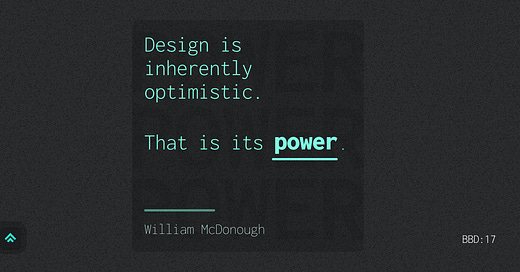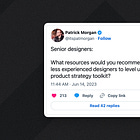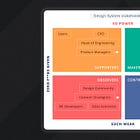
How to Flex the Soft Power of Design
Making an impact when org structures aren't in your favor.
“How can designers get a seat at the table?”
Don’t tap out, tap in.
Remember all those “seat at the table” design articles and conversations?
How could you miss them? They were inescapable for a while.
Frankly, the argument never resonated with me.
To me, it felt like people were talking the talk while avoiding taking the action required to gain the recognition they sought. I want my voice heard as much as the next guy, but that approach never sat well with me because it felt like asking to be given something without earning it and that’s not my M.O.
You don’t get a seat at the table just because you think you deserve it; you get asked to join the table when the people sitting there depend on your guidance.
Complaining about how they aren’t playing by your rules isn’t a recipe for inclusion, it’s the opposite. And like it or not, the best way I’ve found to make progress is to embrace playing the game and influence it using the skills at my command.
Though the “seat at the table” discussions have died down, more recently I’ve been hearing designers express a feeling that’s closer to defeatism. Designers seem to be tapping out because they’re realizing that many companies don’t inherently care that much about design and they feel like they don’t have the power to make it better.
But I think that’s wrong. My optimism is as strong as ever.
I think designers have an incredibly powerful skill set for modern business and that we’re well-positioned to make a difference. It’s just that the power we hold is different from that of the other disciplines with whom we work most closely.
Our power is a soft power.
It might not look how you expect, but it’s no less powerful than any other kind of power when wielded well.
Soft Power
Now you might be thinking “Okay Pat, this sounds promising, but wtf is this soft power thing?” Good question, my friend.
“Soft power” is a term coined by political scientist Joseph Nye in the 1980s. It focuses on the “ability to influence the behavior of others to get the outcomes you want.” This stands in opposition to “hard power” which relies on structural forces to coerce desired behavior.
In my experience, the reality is that designers often have little hard, structural power within modern tech organizations.
We don't directly write the code that keeps the product running.
We don't directly own the roadmap that decides what work gets prioritized.
We don’t even own the connection to the customer like we might have historically (at least not in the enterprise SaaS context I work in, where sales and customer success usually does).
This doesn’t need to result in defeatism though, it just requires that we think differently about how we might impact the system we’re a part of.
So what power does the designer have in this context?
Simple: the power to influence.
A designer’s skill set for influencing behavior is as strong as or stronger than any other discipline employed by a tech company. We have the superpower of being able to think and communicate visually, putting us at a huge advantage relative to most of our peers.
I can’t count the number of times I’ve seen a colleague in engineering or product management struggle to get buy-in for their idea simply because they can’t express it in a simple and compelling format. Pitching any idea in the abstract tends to result in painful wheel-spinning and fruitless discussion. It’s like an episode of House Hunters where the couple goes into a home and simply can’t imagine what it would look like with any other paint color; their inability to visualize makes it a dead end.
As a designer, it’s easy to take this skill for granted because it’s a natural part of the way we see the world: we’re able to envision things that don’t exist and imagine how they might come to be.
Most people do not, or cannot think this way, but it’s where designers excel. We make the intangible tangible and the complex digestible. And with those skills we can spark creation and drive alignment where others fall short.
So is a good designer powerful? You better believe it.
Just not in the way you might have thought.
You don’t need a seat at the table, you just need to tap into your skill-set to influence and nudge the people who are sitting at it in the direction you think is right. The change you affect might feel very gradual, like steering a freight-liner ship, but if you consistently exert this kind of subtle influence, the overall design can veer toward a better destination without anyone ever realizing you were at the helm the whole time.
You probably won’t get the affirmation and praise you deserve, but you will make a difference. And that’s worth striving for.
“Orchestrating Experiences”
I’ll close with a recommendation (and yet another metaphor 🙃).
There’s a great design book called “Orchestrating Experiences” that had a big impact on me earlier in my career.
It has a lot of useful ideas for designers, but the one that has stuck with me the most is simply captured by its title: designers make the biggest impact when we act like the conductor of an orchestra.
We bring vision to our creations and conduct the many disparate parts of the business to come together to make something that feels connected and whole.
Something where the whole feels like more than the sum of its parts.
Design is in a unique position to reach across organizations to facilitate a great end-to-end experience, internal and external, from product and engineering to marketing and sales. Though we may not be the ultimate decision maker on either side, we have the right skills and are ideally positioned to align them to play in concert. Despite all the struggles that come along with orchestrating work across diverse disciplines and personalities, it’s a tremendous feeling when you get them to come together.
Don’t overlook your chance to conduct the show!
If you got a little value in this post, consider subscribing, sharing, or following me on Twitter. If you got a lot of value I’d appreciate it if you bought me a coffee 😎☕️.












This is a great call Patrick. One of the things we've done as a design team is carve out time to spend on more forward-looking speculative future stuff. These kinds of prototypes or screens serve two main purposes, to provoke discussion and to get people excited about an idea. We've had these kinds of designs lead to strategic company shifts, and entire teams being given budget to build a thing. The thing almost *never* resembles the initial designs, but that's OK, the output is not the point, the outcomes are :)